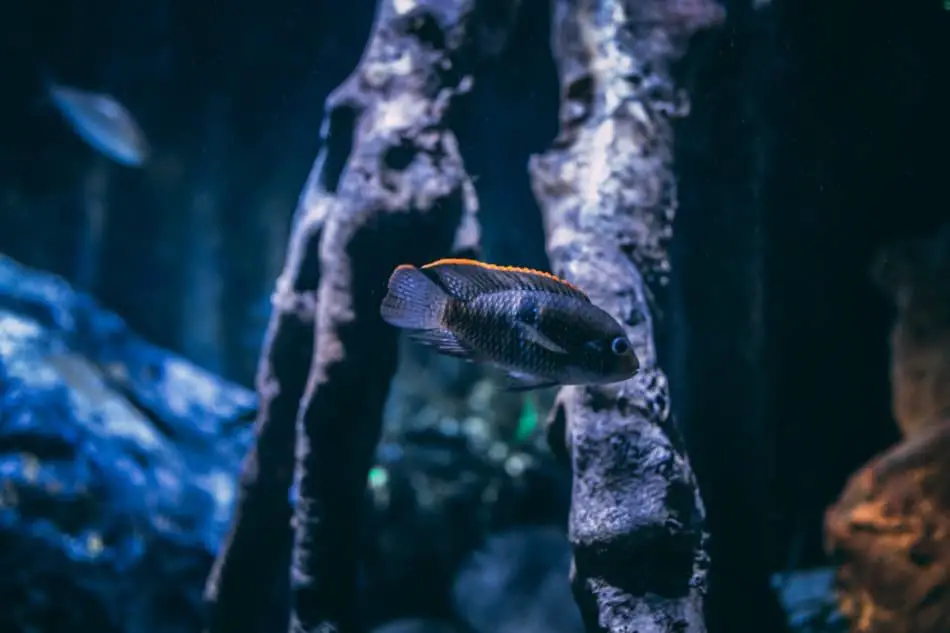 How exactly are you supposed to get a piece of driftwood to sink into an aquarium? It seems that even if you leave it for weeks in the water that it refuses to sink. Should you just throw it away and purchase a piece of driftwood at your local fish store that is guaranteed to sink right away? I say no, and I will explain how to get that your driftwood to eventually stay on the bottom of your fish tank. If you are interested in seeing Spiderwood driftwood that is available on Amazon, click here.
How exactly are you supposed to get a piece of driftwood to sink into an aquarium? It seems that even if you leave it for weeks in the water that it refuses to sink. Should you just throw it away and purchase a piece of driftwood at your local fish store that is guaranteed to sink right away? I say no, and I will explain how to get that your driftwood to eventually stay on the bottom of your fish tank. If you are interested in seeing Spiderwood driftwood that is available on Amazon, click here.
How Long Does it Take for Driftwood to Get Water-logged?
The time that it takes driftwood to get totally water-logged varies greatly depending on the type of driftwood that you adding to your aquarium tank. For instance, if you are using driftwood that is not very porous, it could take up to a year for it to sink, but eventually, it probably will sink to the bottom. You have to have a lot of patience.
I have read that sometimes driftwood will sink on its own if you leave it submerged after just a week. Also, a person in a forum stated that it could take up to a year for ironwood to eventually sink on its own. Also, there are types that can take even longer to sink, such as lignum vitae (it never seems to sink). I avoid that type unless you are willing to anchor it somehow. I will explain some methods to do so later on.
How to Prepare the Driftwood Before Putting it Into the Tank
Even if you have driftwood that is hard to sink, there are some steps that you can take to prepare to be submerged:
- If you had purchased driftwood from a pet store, make sure that it has been pre-submerged. As driftwood decomposes, it will leach out tannins that are toxic to fish. I would suggest that if you are not sure, that you soak it elsewhere over a period of a year, changing the water once a month so that you will get rid of the toxins before you add it to your fish tank.
- If you have a large tank (click here to see a SeaClear acrylic large aquarium available on Amazon) and you have found a larger piece of driftwood on your own, you should definitely pre-soak until it starts to sink. Most of the driftwood that you buy at the pet shop will sink right away.
- If you collected interesting pieces of wood that are just fallen branches, you can still turn them into wood that looks as if it had been drifting for some time. If the wood is green or fresh, you should remove its bark right away since the bark will rot off anyhow. Then you should leave the piece of wood outside to become weathered by the seasons. I would suggest that you leave it outside for at least a year. Nevertheless, try to avoid using wood from nut trees or conifers since they will tend to be more toxic.
Different Ways to Anchor Driftwood in an Aquarium
There are numerous methods that will work well for driftwood that is refusing to sink. You have to make sure that you use materials that are not going to add toxins to the tank water nevertheless. Here are a few methods that will work wonders on your floating driftwood problem:
- Tieing something to the unsinkable driftwood. You could, first of all, attach stainless steel wiring to the piece of driftwood using brass screws and then anchor the wood to a rock that you could bury in the gravel that is at the bottom of the tank.
- Another method is to simply wedge it between a couple of rocks that are in the tank. What I like about this method is that it simple to do and you could release it later on once it becomes waterlogged enough to remain at the bottom on its own.
- You could glue it down. Of course, you cannot glue it to sand or gravel that is in the tank since it will probably float to the surface with the debris sticking to it. You could take out a stone and then superglue it to the stone and then place the stone back into the tank once the glue is completely dry. As a side note, make sure that you use glue that is designed to work with driftwood for aquariums (I recommend HoldFast glue available on Amazon) since to avoid adding toxins to the water that might be present in some glues.
- There are certain plants that are strong enough that you can entangle the driftwood. This might sound barbaric but it is actually what happens to driftwood in watery environments.
- Another material that works great for anchoring driftwood is plexiglass. Use the plexiglass as the base and screw it to driftwood. Once you have placed the plexiglass into the tank, cover it with the surrounding sand and it will look as if the piece of driftwood has sunk.
You might be wondering if using different methods to anchor driftwood is going to stress your fish. They will be ok since it is not an activity that you will need to repeat on a daily basis.
Are your Fish More Stressed When the Driftwood is Floating Around?
If you are allowing your driftwood to float freely until it becomes water-logged enough on its own to sink, that is not going to disrupt the tranquility for your fish friends. It will probably make fish life more interesting for them since they can swim around the driftwood for entertainment.
Of course, I would not be playing around positioning driftwood for days on end. Once you have added your driftwood to your tank, let it be.
Also, if you are intending on adding numerous pieces of wood at the same time, this can hinder fish feeding time since the fish are in competition for food that is added to the surface of the water. Too many pieces of wood are going to slow down larger fish that will not be able to weave between pieces of floating driftwood.
Will the Tannins that Driftwood Reaches While Floating Harm Fish?
As a piece of driftwood is absorbing water, it could be releasing tannins. Tannins are not usually harmful to fish when in small doses. You may notice that your tank water is becoming cloudy after a few days of exposure to driftwood that is not yet water-logged.
As long as you have a relatively large tank, the amount of tannins is the water is not endangering your fish. It might just make it harder for you to enjoy watching your fish friends due to the brownish color in the tank.
If you are worried about the level of tannins, ensure that you have a carbon filter in your tank. If your filter is in working order, it will clear your tank of tannins as soon as they are leached into the water.
Some people try to avoid the leaching of tannins by boiling the driftwood before adding it to the water. I would not boil it to death though, doing so will alter its look and shape. If you are just boiling it to remove tannins, you may need to boil the wood for around an hour. If you are wishing to simply disinfect the wood to kill bacteria and spores, 10 minutes of boiling is fine.
Does Boiling Driftwood Make it Sink?
Boiling driftwood is not going to be it sink faster versus soaking it in water beforehand. In actuality, you are going to increase the time that it takes to sink it. I did some research and discovered that boiling wood releases resins and tars in wood that holds in water. In other words, you are going to dry out the wood more so which is going to cause it to become less sinkable.
Nevertheless, I personally feel that is a good practice to boil it even if you were to purchase it from a fish store. A large boiling pot that I recommend by Mr. Rudolf is available today on Amazon. They may state that it has been sterilized, but why take the chance of adding toxins to your fish tank.
Happy Driftwood Sinking
Just remember to have lots of patience and perhaps boil your driftwood for 10 minutes or so before adding it to your aquarium.
Your fish are going to really appreciate the added beauty to their tank.
